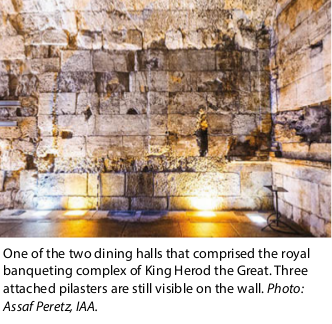

Did archaeologists find the royal banqueting complex of King Herod the Great in Jerusalem? Hebrew University of Jerusalem professor Joseph Patrich and Israel Antiquities Authority archaeologist Shlomit Weksler-Bdolah believe so, and they present the find in “Old, New Banquet Hall by the Temple Mount” in the March/April 2017 issue of Biblical Archaeology Review. According to Patrich and Weksler-Bdolah, this dining complex “is arguably the most splendid Herodian building to have survived the Roman destruction of Jerusalem.” Part of the building complex in question was first discovered by pioneering archaeologist Charles Warren (later Sir Charles Warren) in 1867. Warren had excavated a magnificent hall, which he called the Free Masons Hall, some 400 feet from where the Jerusalem Temple stood. The building was investigated again in the 1960s, but it wasn’t until the renewed excavations, led by Alexander Onn of the Israel Antiquities Authority between 2007 and 2012, that the complex was uncovered in its entirety.
The recent exploration revealed a building that Patrich and Weksler-Bdolah believe to be the royal banqueting complex of King Herod the Great, located only 75 feet from the Western Wall of the Temple Mount. An elaborate room identical to Warren’s Free Masons Hall, dubbed the Western Hall, was found; archaeologists now believe these were dining halls (see Rooms 21 and 23 below). In between the dining halls, a fountain room and a reservoir were discovered.

The dining halls were set up in the style of Greco-Roman triclinia, where couches for reclining and eating would have been placed alongside the walls. While the couches themselves have not been preserved, their traces remain visible on the walls of the dining rooms.
In between the dining halls was a fountain room elaborately decorated with six adorned pilasters (see image below). The Corinthian capitals that topped the pilasters had holes cut into them, serving as fountain heads through which water from the hidden reservoir flowed.

"The architectural style, magnificence and sophistication of the building, with its integrated fountain, suggest that it was sponsored by Herod himself," write Patrich and Weksler-Bdolah.
Contact
Kenneth Gallaher
P.O. Box 172 Dumaguete City 6200 Negros Oriental Philippines
Phone 09267241765
email-gallkr1@gmail.com